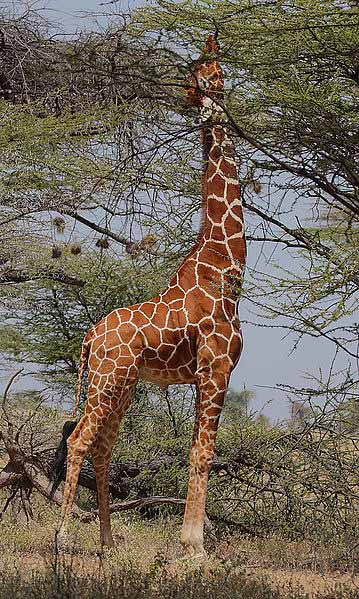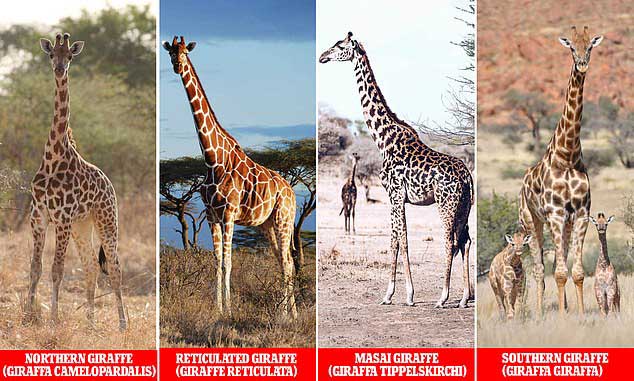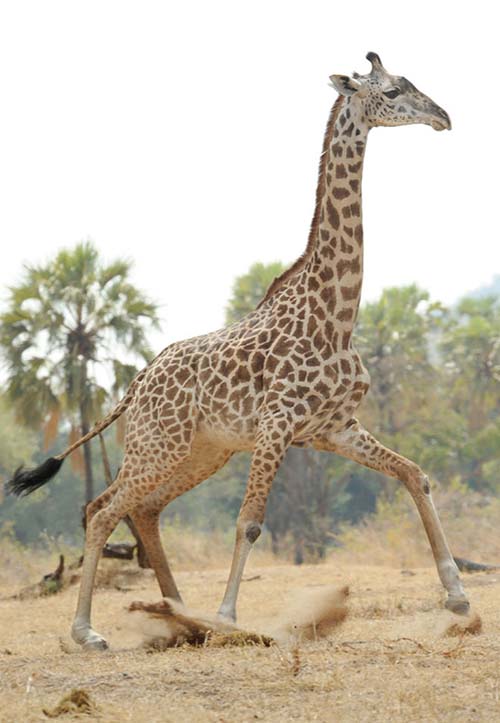

The giraffe (Giraffa camelopardalis) is an African even-toed ungulate mammal, the tallest living terrestrial animal and the largest ruminant. Its specific name refers to its camel-like face and patches of color on a light background, which bear a vague resemblance to a leopard's spots.
The giraffe is noted for its extremely long neck and legs and unusual horns. It stands 5-6 m (16-20 ft) tall and has an average weight of 1,600 kg (3,500 lb) for males and 830 kg (1,800 lb) for females. It is classified under the family Giraffidae, along with its closest extant relative, the okapi. There are nine subspecies, which are distinguished by their coat patterns.
The giraffe's scattered range extends from Chad in the north to South Africa in the south, and from Niger in the west to Somalia in the east. Giraffes usually inhabit savannas, grasslands, and open woodlands. They prefer areas with plenty of acacia trees, which are important food sources, and can browse at heights that most other herbivores cannot reach.
While adults are nearly invulnerable to predation, lions, leopards, spotted hyenas and wild dogs prey on calves. Giraffes commonly gather in aggregations that usually disband every few hours. Males establish social hierarchies through "necking", which are combat bouts where the neck is used as a weapon. Dominant males gain mating access to females, who bear the sole responsibility for raising the young.
The giraffe has intrigued various cultures, both ancient and modern, for its peculiar appearance, and has often been featured in paintings, books and cartoons. It is classified by the International Union for Conservation of Nature (IUCN) as Least Concern, but has been extirpated from many parts of its former range, and some subspecies are classified as Endangered. Nevertheless, giraffes are still found in numerous game reserves. Read more

Camelopardalis is a large but faint constellation in the northern sky. The constellation was introduced in 1612 by Petrus Plancius. Some older astronomy books give an alternative spelling of the name, Camelopardus. First attested in English in 1785, the word camelopardalis comes from the Latin and it is the romanization of the Greek meaning "giraffe", "camel", due to its having a long neck like a camel and spots like a leopard.
The giraffe is a messenger, encouraging us to stretch our vision and consciousness, to reach as far as we can on the tree of life. The giraffe represents, higher perception and vision as you quest for answers, patience, elegance, gracefulness, intelligence, intuition, protection, gentleness of spirit, resourcefulness, cleverness, intelligent, and beauty.
There Are Actually Four Distinct Species Of Giraffe - And Their Skulls Confirm It IFL Science - December 24, 2024

Wonky-Necked Giraffe Spotted In South Africa Is Somehow Still Alive IFL Science - August 2, 2024
A rare baby giraffe was born without spots, a Tennessee zoo says CNN - August 23, 2023

There’s a brand new spotless superstar on the scene at a Tennessee zoo. She doesn’t have a name yet, but she’s already made a big splash among her herd – she’s a giraffe without patches. The 6-foot wonder was born sans spots on July 31 at Bright’s Zoo, a privately owned facility in Limestone, and made her public debut this month. The calf is a reticulated giraffe, one of four giraffe species.
Scientists confirm there are four distinct species of giraffe, not just one - and they're as different as brown and polar bears Daily Mail - May 6, 2021

Spread from north to south Africa, the four distinct species of giraffe are: Northern giraffe, Reticulated giraffe, Masai giraffe and Southern giraffe.
World's only known white giraffe fitted with tracker to deter poachers BBC - November 18, 2020
The world's only known white giraffe has been fitted with a GPS tracking device to keep poachers at bay in north-east Kenya, conservationists say. A conservation group said rangers could monitor the lone male giraffe's movements in real time. The giraffe has a rare genetic condition called leucism, which causes the loss of skin pigmentation. He is thought to be the last of his kind, after poachers killed two of his family members in March
Rare white giraffes are spotted in Kenya and captured on video for the first time Daily Mail - September 14, 2017
The footage of the distinctive giraffes was filmed in the Ishaqbini Hirola Conservacy in Kenya's Garissa county by conservationists after locals tipped them off.
How Do Giraffes Stay So Cool? Perhaps the Secret Is a Long Neck Smithsonian - September 14, 2017
Reaching high-up food may not have been the only or even main reason giraffes evolved to have long necks, as new research suggests that these extended body parts help the animals keep cool in the hot African savannah.
Video: Giraffes facing 'silent extinction' as population plunges BBC - December 8, 2016
A dramatic drop in giraffe populations over the past 30 years has seen the world's tallest land mammal classified as vulnerable to extinction. Numbers have gone from around 155,000 in 1985 to 97,000 in 2015 according to the International Union for the Conservation of Nature (IUCN). The iconic animal has declined because of habitat loss, poaching and civil unrest in many parts of Africa. Some populations are growing, mainly in southern parts of the continent. Until now, the conservation status of giraffes was considered of "least concern" by the IUCN.
Giraffe genetic secret: Four species of tallest mammal identified BBC - September 8, 2016

This is a clear indication that they have evolved into distinct species.
How the Giraffe Got Its Iconic Neck Live Science - October 7, 2015
The age-old question of how the giraffe got its long neck may now be at least partly answered: Long necks were present in giraffe ancestors that lived at least 16 million years ago, a new study finds. In the study, researchers examined the cervical (neck) vertebrae from 71 animals, including modern giraffes, their relatives and their ancient ancestors. They found that two species - Prodremotherium elongatum, which lived 25 million years ago and was potentially an ancestor of modern giraffes, and Canthumeryx sirtensis, which was a giraffe ancestor that lived 16 million years ago - both had elongated necks. These ancient animals were different enough from their modern counterparts that they are not classified as part of the giraffe family. Therefore, the fossils indicate that "cervical lengthening precedes Giraffidae," the researchers wrote in the study, using the scientific name for the giraffe family.
astrobiology1210